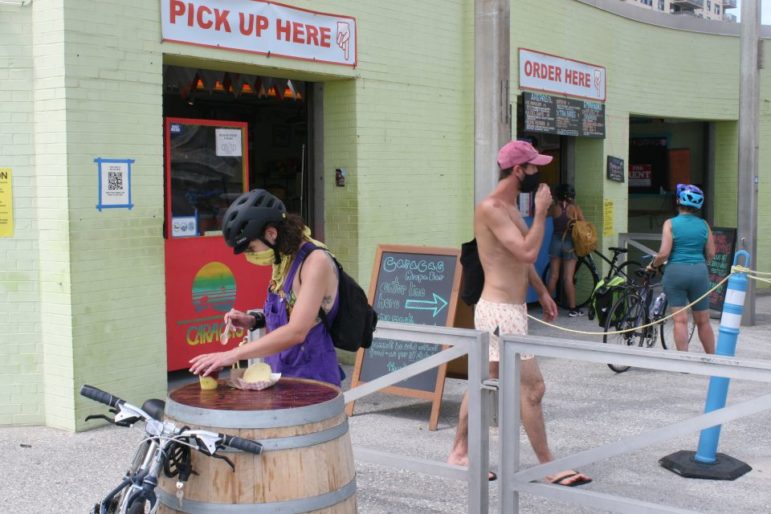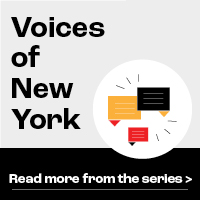Some of the business owners who struggled through the summer of COVID remember the impact of the 2001 plane crash and a 2012 superstorm on the peninsula.

Fernando Martínez
Only 50 percent of the 30 businesses on the Rockaway Boardwalk were able to open.This story originally appeared in El Diario.
Translated by Carlos Rodriguez from Spanish.
As this year’s atypical summer season is coming to an end, the restrictions imposed to curb the COVID-19 pandemic have meant that, for many merchants and restaurant workers on New York City beaches whose livelihood depends on the crowds gathering during the warm months, the season never even started.
On Labor Day weekend, when the Big Apple bade farewell to summer 2020, entrepreneurs and seasonal workers at popular spots like Queens’ Rockaway Beach had no choice but to hope for better luck next year.
Nearly 50% of the 30 commercial establishments operating in the summer along the Rockaway Boardwalk, between 86th and 106th Streets, were banned from opening as part of the city’s strategy to avoid overcrowding and prevent the spread of COVID-19.
One of the affected merchants was Angela Sierra, 50, a gastronomic entrepreneur from Colombia who for five years has been serving traditional food from her native land at her Palenque restaurant.
“We could not reopen. The managers did not allow it. As an entrepreneur, I am always looking to innovate and find options, but we were given no alternatives. There was no plan for us. We remain optimistic that we will be able to come back next year,” said Sierra.
By the end of the season, establishments along the boardwalk which were not allowed to reopen – even for outdoor service or takeout – had seen zero income. Their misfortune was shared by hundreds of other seasonal merchants operating in nearby areas whose customers are the beachgoers. They will have the next 9 months to rethink their businesses if the pandemic continues to be a threat.
El Salvador native Julio Geromi, 35, is used to making “good money” in tips during the summer season. This year, he said, all he did were a couple of deliveries for a restaurant on 97th Street, near the Beach 98 Street subway station.
“Many people came down on the weekends when we had good weather. The virus did not stop them, but it did end many businesses. It will be dead around here again in the next few weeks,” said Geromi.
Despite the fear of contagion and the new rules requiring people to wear masks and maintain social distancing, Rockaway Beach continued to be one of the favorite places for New Yorkers seeking relief from the heat and from the lockdown enforced due to the pandemic.
Puerto Rican-born Deisy Cartagena witnessed how beachgoers came to the Queens beach in large crowds.
“I live a few blocks from here. I honestly did not feel a big difference from the number of people who came last year. There were weeks when this place was packed. People were tired of being indoors. But they were respecting the rules,” said Cartagena, who visited the beach frequently.
Some restaurants were able to ride the wave of the crisis and, despite being banned from reopening, sold food by establishing collection points across the beach. This was a lifesaver for many during this turbulent season.
That was the case of La Cevichería, a popular Peruvian eatery, which was unable to reopen its 97th Street location on the boardwalk. Still, the restaurant continued to distribute orders of its wide selection of ceviche and seafood dishes by taking orders by phone and bringing them to a pick-up point between 94th Street and the waterfront promenade. They also offered the option to collect orders at a pop-up location on a 116th Street cafe.
“We were able to stay afloat. We had work, which does not mean that it was the same as other times,” said an employee.
It was a different story for businesses that were allowed to reopen under certain restrictions. One of them was Caracas Arepa Bar, on 105th Street at the beach boulevard, a Venezuelan food restaurant.
“We did not have great expectations for this season. However, despite social distancing, we can’t complain about how the summer is ending for us. We served our customers, and we kept people in their jobs,” said manager Alexis O’Connor.
On the other hand, no concerts were held in the area, which means that people were unable to dance on the boardwalk this year. Equally, establishments were only allowed to bring outside a limited number of tables to avoid causing large gatherings as in previous years.
“There were no incidents or issues with social distancing inspectors because we adapted the space to the urgent requirement of keeping social distancing. Our kitchen staff was very busy, but we were very strict about their protection,” said O’Connor as she coordinated the delivery of several orders of arepas, a traditional dish of the South American country.
Merchants on the popular New York beach, located between 91st and 102nd Streets, had already been through mandatory closing during the dredging of the East Rockaway Inlet in 2018. The work involved extracting sand to replenish parts of nearby terrain, eroded by several weather events, such as Hurricane Sandy.
According to merchant Agustín Rivas, 62, the entrepreneurial sector in the peninsula has been forced to get back on its feet after three tragedies in recent years, one worse than the other.
“We went through the plane crash in 2001, then Hurricane Sandy in 2012, and now the pandemic, which we don’t really know how long is going to last. If we are still in the same place next summer, it will be terrible. Small restaurants without the means to have outdoor seating will not be able to survive with deliveries only,” Rivas said. (On November 12, 2001, American Airlines Flight 587 crashed in Belle Harbor shortly after takeoff from JFK, killing 260 people on-board and five on the ground.)
Rockaway’s zip codes 11694 and 11691 are Queens coastal areas identified as among the most affected by COVID-19, according to a map from the City’s Department of Health and Mental Hygiene (DOHMH.)









